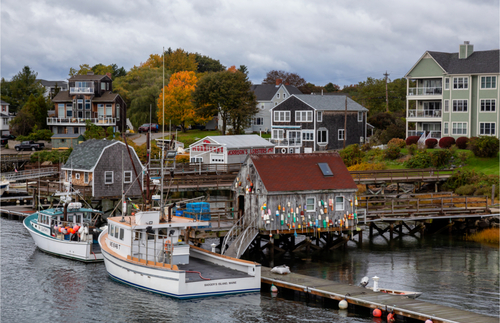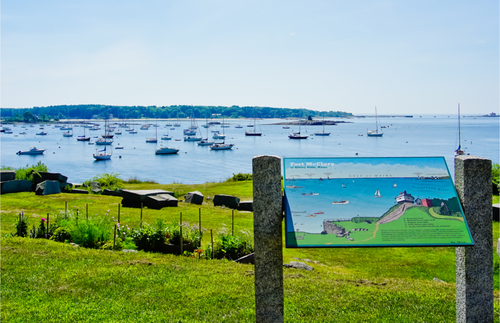
Since 2012 or so, the historic Foreside neighborhood has become Kittery’s snug, hip town center. Once a rough-around-the-edges district catering to off-duty shipyard workers, Foreside now hosts a few of the state’s most acclaimed bars and restaurants, plus indie-fied enterprises like eclectic arts venue The Dance Hall (tel. 207/703-2083) and rustic-mod accessories boutique Folk (tel. 207/703-2526). It’s a great few blocks where you can crush a craft beer or a cruller while mingling with student scenesters, young families, and Navy folks in their digital blues.
Nearby, the Portsmouth Naval Shipyard faces Portsmouth, New Hampshire. This active shipyard isn’t open to the public for security reasons, but you can visit the Kittery Historical & Naval Museum (tel. 207/439-3080) to get a quick overview of maritime history. You’ll find ship and sub models, lighthouse lenses, scrimshaw work, diving suits, and the like—plus muskets, utensils, and tools from another era. For maritime history fans it's catnip. From June through October, the museum’s open Wednesday through Sunday, from 10am to 4pm; in the off-season, it’s only open Wednesdays and Saturdays, with the same hours. Admission is $7 for adults, $3 for children, and $15 for a family. Find it by taking U.S. Route 1 to the Kittery traffic circle, then exiting for Route 236 south; that’s Rogers Road. Continue to the end and Rogers Road Extension.

From Kittery, an attractive alternative route north to York follows winding Route 103 to the historic, lost-in-time village of Kittery Point (see above). It’s perfect for driving, though a bit busy and narrow for biking. Kittery Point homes seem to be just inches from the roadway and there are not one but two historic forts; both are parks open to the public.
Exploring the Yorks
York is split into several village centers, from colonial-era York Village to laidback York Harbor to the beach-town hubbub of York Beach. The best for walking around in is York Village, a terrific destination for those curious about early American history. First settled in 1624, the village opens several homes to the public and is the home to an infamous flop in the life of Founding Father John Hancock.
John Hancock is justly famous for his oversize signature on the Declaration of Independence, his tenure as governor of Massachusetts, and the insurance company and tall Boston building that were named for him. What’s not so well known is his involvement as a proprietor of York’s Hancock Wharf, a failed 18th-century wharf-and-warehouse enterprise that went bust. Hancock never actually set foot on the wharf, but for years locals believed he used it to stash arms, contraband, and/or goods he didn’t want taxed by those tax-happy British. It now appears that wasn’t the case, but it still makes for one of the many intriguing sites and stories in the York Village section of downtown York.
Surprisingly, the wharf has a happy ending: It’s more famous today than it was then, the only 18th-century warehouse still standing on the York River. It has been designated a National Historic Site, and the York Historical Society sometimes uses it to launch or receive the occasional historic boat passing through town.
Finally, while visiting Kittery and the Yorks, don’t forget that Portsmouth, New Hampshire makes a worthwhile side trip—in fact, if you’re seeking culture, arts, coffee shops, and top-flight restaurants, you’ll find a wealth of options on the New Hampshire side of the river. Best of all, it’s just a half-mile from Kittery, or a few minutes’ drive from the Yorks.
Note: This information was accurate when it was published, but can change without notice. Please be sure to confirm all rates and details directly with the companies in question before planning your trip.








